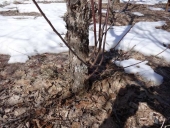I know some of you guys are working with a cutting you bought or just have, but if the tree is nearby you could just bend one of the longer branches over and pin it to the ground with some rocks, about 8-10" from the tip. This works better with bushier plants. Also, it speeds it up if you push a bit of soil over the part you're pinning so it really has good contact to make roots. This works really well with roses!
Another thing I have found, in general is that those branches that shoot straight up [called watersprouts in aboriculture] are less attached to the tree so they are more willing to root for you. You'll see them in stressed out, or unnaturally shaped trees. Interesting tidbit, they do that because they know they are structurally unsound so they are making little them's to help support themselves, and as a contingency for continuance if they break up and can't get to the reproducing bit of life. [hope that bit made sense.. it did in my head XP] Same for sucker sprouts [for both cuttings at the supporting purpose]. You can just slice them off with a shovel and call it peachy. When neighbors have a tree that tends to do this, I like to offer to snip them off for them.

You get good neighbor points and a tiny tree!
Then you just have to keep it nice and moist. If the branch is to big for a baggy you can get those really big produce bags at grocery stores that they have for lettuce. Just make sure you have something to keep it off of the actual cutting cause it can be a place for water to rest against the plant. So a bent willow branch or something works with it planted in some moss or shredded paper. I wouldn't go much bigger than a foot. The ratio of wood to root needs to be right or it just gives up, so don't give it to high of a wood ratio to meet. Oh and making the bottom be a diagonal cut exposes more meristematic tissue [think stem cells] which can grow to be the roots. [Love botany!]
Trying at maple cuttings pretty soon here. Good luck with the figs!






